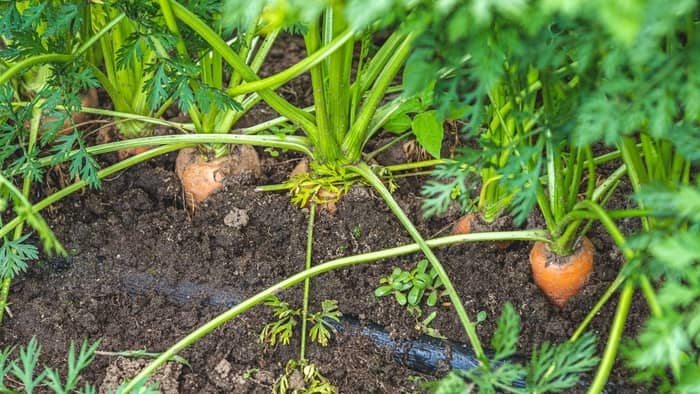As a gardener, determining the optimal watering schedule for your carrot seeds is crucial for maximizing germination rates and getting a healthy crop. Carrot seeds need consistent moisture to sprout and become established. However, overwatering can easily lead to issues like seed rot or fungal diseases. In this comprehensive guide, we’ll explore everything you need to know about how often to water carrot seeds for the best results.
Understanding Carrot Seed Water Needs
Before diving into specific watering recommendations it’s helpful to understand why carrot seeds have particular water requirements
-
Carrot seeds germinate best in consistently moist soil. Fluctuations in soil moisture can reduce germination.
-
However, soils that stay soggy and waterlogged will cause the seeds to rot before sprouting.
-
The small size of carrot seeds makes them prone to drying out in hot weather if watering is insufficient.
-
Once sprouted, carrot seedlings still need adequate moisture while developing their first true leaves.
-
After seedlings are established, water needs decrease as the carrot taproots grow deeper into the soil.
Keeping these factors in mind will help you provide the right amount of water at each growth stage,
Watering Frequency Guidelines
When it comes to watering frequency for carrot seeds, follow these general guidelines:
During Germination
- Water 1-2 times per day to keep seeds consistently moist.
- Check soil moisture daily by digging down 1 inch. Water if dry at this depth.
- Mist soil surface gently to avoid washing away seeds.
- Reduce frequency after most seeds have sprouted.
Seedling Stage
- Water 1-2 times per week, up to 3-4 times in hot weather.
- Look for wilting leaves or soil drying 1 inch down as signs to water.
- Gradually taper off watering as seedlings mature.
Established Plants
- Water 1 time per week unless rainfall is minimal.
- Apply 1-2 inches per week until harvest time.
- Check soil moisture 2-3 inches down before watering.
Adjusting your watering schedule according to the plant’s stage of growth is crucial Overwatering mature plants can split roots
Watering Methods for Carrot Seeds
How you actually water carrot seeds makes a difference in germination success. Here are effective techniques:
- Use a gentle spray setting on a hose end nozzle or watering can.
- Position sprinklers or soaker hoses to avoid direct contact with seeds.
- Consider bottom watering seed trays by partially submerging.
- Install drip irrigation on a timer to automate watering once sprouted.
Take care to moisten soil without disturbing seeds. Bottom watering gives excellent results. Mulch also helps retain moisture between waterings.
How Much Water Do Carrot Seeds Need?
Carrot seeds are tiny and require relatively little water volume to stay consistently moist. Follow these guidelines for how much:
- During germination, apply enough water to moisten seeds to a depth of 1⁄4 to 1⁄2 inch.
- After sprouting, gradually increase depth, watering to 6 inches down at seedling stage.
- At maturity, aim to keep root zone moist to a 12 inch depth.
The required volume of water depends on soil type. Sandy soils require more frequent applications of less water than clay soils.
Tips for Proper Watering Technique
Proper technique when watering is just as important as frequency and volume. Keep these tips in mind:
- Water in early morning to give foliage time to dry out rather than at night.
- Avoid overhead watering once seedlings emerge to limit disease pressure.
- Water at base of plants rather than leaves after seedling stage.
- Use soaker hoses or drip irrigation for most efficient moisture delivery.
- Monitor soil moisture before and after watering to gauge effectiveness.
Good watering technique promotes healthy soil and reduces issues like fungal diseases.
Common Watering Mistakes
It’s also helpful to understand common watering mistakes to avoid with carrot seeds:
-
Insufficient watering leading to poor germination due to dry soils.
-
Overhead watering once seedlings emerge causing foliar diseases.
-
Infrequent deep watering leading to cracked and forked carrots.
-
Saturating soils resulting in seed rot and root rots.
-
Not reducing watering amounts as plants mature resulting in split roots.
-
Watering late in the day leaving foliage wet overnight.
Be vigilant about avoiding these missteps for the best results from your carrot crop.
Watering based on Soil Type
Soil composition directly affects how you should adjust your watering habits:
Sandy Soil
- Requires more frequent watering, 2-3 times as often.
- Drainage reduces risk of overwatering.
- Lower volume per watering, only moisten top few inches.
Clay Soil
- Water less frequently, 1-2 times as often.
- Poor drainage increases risk of waterlogging.
- Higher volume per watering, wet entire root zone.
Loam Soil
- Offers good balance of water retention
Optimal sOIL & sun
Like most vegetables, carrots prefer a slightly acidic to neutral soil (6. 5-7. 0 range. ) Carrots love loose, sandy, well-drained soil. It’s a good idea to loosen your carrot plot with a digging fork or shovel before planting.
Carrots need at least six to eight hours of sun a day, but they can grow in some shade as well. They’ll just take longer to mature. In shady gardens, you’ll have to wait a little longer for your crop.
Carrots are relatively drought-tolerant if given plenty of water early on in the growing season. Thirsty roots may crack under too much water stress but will still taste good.
Carrot seeds are long and very small. They grow best when planted directly in the ground, either in rows or all over the garden.

How Often to Water Carrots: Expert Gardening Guide
- The Ultimate Guide to Growing Strawberries in Raised Beds - August 8, 2025
- No-Dig Garden Beds: The Easiest Way to Grow a Beautiful Garden - August 6, 2025
- How to Protect and Preserve Wood for Raised Garden Beds - August 6, 2025

